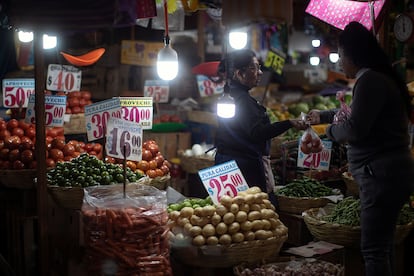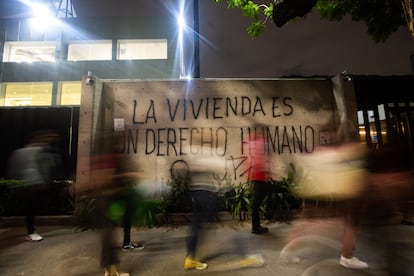Mexico City is more expensive than Milan (but only for wealthy foreigners) – EL PAÍS USA
4 min readMexico City is the world’s 16th most expensive city, above the likes of Washington D.C. and Milan. This was the headline that appeared in many newspapers when the ranking of the Worldwide Cost of Living Index, published by the prestigious magazine, The Economist, was released a week ago. But how can millions of capital city inhabitants who on average earn 4,600 pesos a month — about $272 — live in such an expensive metropolis? The fine print of the study clarifies that the list is compiled so that companies can calculate compensation for “expatriates and business travelers.” The methodology, which calculated the index with a weaker dollar against the 2023 ‘super peso’, the gentrification of certain neighborhoods and Mexican inflation are other factors behind the capital’s ranking among the most unaffordable cities, experts say.
It is not the same for a family to pay the average rent in Iztapalapa, at 13,022 pesos, as for a digital nomad who earns in dollars to live in Roma area, where the average rent is double, according to the property website, Real Estate Market. Or buying in a market rather than in a large area, where the price gap may be as much as 50%. “To make accurate comparisons, it is not only necessary to measure the cost in dollars of the main goods and services, but also to take into account the income in each of these cities and the possibility of acquiring these goods more easily,” explains Rodolfo de la Torre, director of social development with equity at the Centro de Estudios Espinosa Yglesias.
The Economist measured 400 individual prices of more than 200 products and services in 173 cities. These included beverages, food, clothing, telephone rates and public transportation. One of the reasons why the Mexican capital jumped from 76th place to the top 20 is the inflation that affected the country throughout 2023. And although the index might measure prices for foreign workers, the Consumer Price Index for food, with an annual rate of 6.25%, has stung everyone’s pockets. “Inflation has been high for food products. Much higher than for goods and services,” explains De la Torre.

One price that contradicts the list concerns public transportation. “In transportation there has been price stability due to a large subsidy,” explains the director of the think tank. The five pesos for a metro ticket — about $0.30 — is far less than the $2 fare to ride the urban train in Washington D.C. The Economist converts global city prices to U.S. currency, and while the subway remains inexpensive for high-wage earners, it is pricier than in 2022 for foreign currencies because of the revaluation of the peso that began early last year.
The coordinator of the Laboratory of Analysis in Commerce, Economics and Business (LACEN) of the National Autonomous University of Mexico (UNAM), Ignacio Martínez, believes that costs for foreigners have risen, although prices have not changed in certain sectors. “It is not the same for Americans to come here with an exchange rate as it was a year ago, at 20 pesos, as at 16, which is the case now. This makes all the services more expensive for them,” Martínez contrasts with the payments made by Mexicans, who purchase many products and services in pesos at the same price as last year. De la Torre believes that the study should have measured purchasing power parity, which in the process of converting currencies eliminates price differences between countries.
The element that marked the difference in this 2023 index was that of housing. Interest rate increases up to 11.25%, a lower supply due to the slump in construction and inflation pushed housing prices up 11.6% in just one year, according to the Sociedad Hipotecaria Federal (SHF). “The cost of housing in Mexico City has become increasingly higher than in other countries,” points out De la Torre.

This price has surged especially in the gentrified downtown neighborhoods, which are mainly occupied by foreign workers — for whom the Economist rankings are made — in Mexico City. “Gentrification shows that there is an unsatisfied demand for high quality housing, which makes the areas rise that can be remodeled, where housing can be rebuilt and that are close to certain amenities. The demand for this type of location is quite substantial,” outlines De la Torre. The accumulation of services also has an influence. “There has been public investment in basic infrastructure: subway lines, pavements, investment in security. You see patrols on every four or five streets. All these services make it more expensive,” Martínez says.
The other side of the picture involves the displacement of the local population to peripheral colonies. Increasingly farther away from their jobs, in more precarious housing and areas. “These people live in peripheral areas, where public services like lighting, sanitation and drinking water are not of very good quality and housing is not very expensive,” complains the director at Espinosa Yglesias. “Mexico City differs from Washington, Milan, in that in these cities there is territorial development where income and price increases are homogeneous,” explains the coordinator of the LACEN at the UNAM. Here, the inhabitants move to the peripheral areas of the capital or to the State of Mexico. This is the vast majority of the population that does not reside in the 16th most expensive city in the world.
Sign up for our weekly newsletter to get more English-language news coverage from EL PAÍS USA Edition



